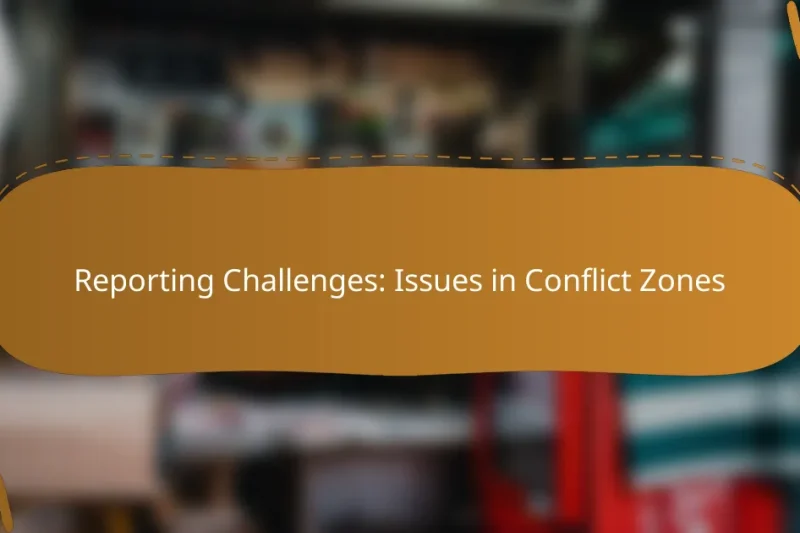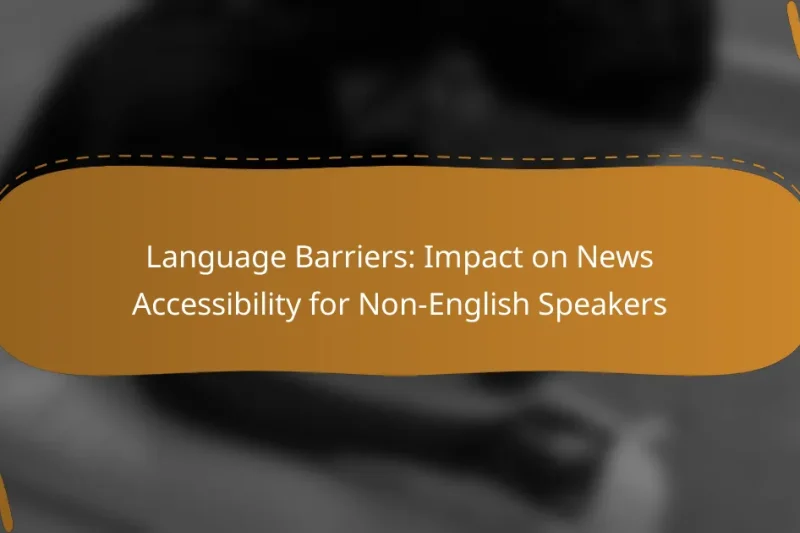Representation of minority voices in global news reporting is crucial for creating a more inclusive media … Minority Voices: Representation in Global News ReportingRead more
Challenges in Global News Coverage
Global news coverage faces numerous challenges, including geopolitical tensions, language barriers, and access to reliable sources. These obstacles can hinder the accuracy and effectiveness of reporting, making it essential for news organizations to adopt strategic measures to enhance local engagement and ensure reliable information dissemination. By investing in local journalism and leveraging technology, they can better connect with audiences and address the complexities of reporting on a global scale.
Geopolitical Events: Influence on Global News Coverage
Geopolitical events play a crucial role in shaping global news coverage, influencing which stories are highlighted … Geopolitical Events: Influence on Global News CoverageRead more
International Correspondents: Role in Shaping Global News Narratives
International correspondents are essential in shaping global news narratives through their on-the-ground reporting and unique perspectives. … International Correspondents: Role in Shaping Global News NarrativesRead more
Climate Change Coverage: Challenges for Global Audiences
Climate change presents significant challenges for global audiences, manifesting in extreme weather events, rising sea levels, … Climate Change Coverage: Challenges for Global AudiencesRead more
Reporting Challenges: Issues in Conflict Zones
Reporting in conflict zones presents numerous challenges, including journalist safety, access to reliable information, and ethical … Reporting Challenges: Issues in Conflict ZonesRead more
Local Events: Global Attention and Case Study Insights
Local events have the potential to capture global attention by effectively utilizing digital platforms, influencer partnerships, … Local Events: Global Attention and Case Study InsightsRead more
Language Barriers: Impact on News Accessibility for Non-English Speakers
Language barriers pose a significant challenge to news accessibility for non-English speakers, hindering their ability to … Language Barriers: Impact on News Accessibility for Non-English SpeakersRead more
What are the main challenges in global news coverage?
The main challenges in global news coverage include geopolitical tensions, language barriers, access to reliable sources, technological disparities, and regulatory constraints. Each of these factors can significantly impact the accuracy and effectiveness of news reporting across different regions.
Geopolitical tensions
Geopolitical tensions can create significant obstacles for journalists seeking to report on events in conflict zones or politically sensitive areas. Reporters may face restrictions on movement, increased risks to their safety, and government censorship, which can hinder their ability to gather accurate information.
For example, in regions experiencing civil unrest, media outlets may be forced to rely on local sources or social media, which can lead to misinformation. Understanding the political landscape is crucial for journalists to navigate these challenges effectively.
Language barriers
Language barriers present a major challenge in global news coverage, as journalists may struggle to communicate with local populations or interpret nuanced information accurately. This can lead to misrepresentation of facts or cultural misunderstandings in reporting.
Using professional translators or local correspondents can help mitigate these issues, but it often requires additional resources and time. Journalists should prioritize learning key phrases in the local language to enhance their engagement and understanding.
Access to reliable sources
Access to reliable sources is critical for accurate news reporting, yet it can be difficult to obtain in certain regions. Journalists may encounter challenges in verifying information due to limited access to official channels or credible local voices.
Building relationships with trustworthy local contacts and utilizing established networks can improve access to reliable information. Journalists should also be cautious of relying solely on social media, as it can be a source of unverified claims.
Technological disparities
Technological disparities can affect the quality and speed of news coverage, particularly in developing regions where internet access and digital tools may be limited. Journalists in these areas may struggle to disseminate information quickly or utilize advanced reporting technologies.
To address this, media organizations can invest in training local journalists on digital tools and provide resources to enhance their reporting capabilities. Utilizing mobile technology can also help bridge some gaps in communication and information sharing.
Regulatory constraints
Regulatory constraints imposed by governments can significantly impact global news coverage. Laws regarding press freedom, censorship, and foreign correspondents can vary widely, affecting how journalists operate in different countries.
Understanding local laws and regulations is essential for journalists to navigate these constraints effectively. Media organizations should provide training on legal rights and responsibilities to help reporters operate within the legal frameworks of the regions they cover.
How can news organizations address these challenges?
News organizations can tackle challenges in global news coverage by implementing strategic measures that enhance local engagement and accuracy. Key approaches include investing in local journalism, utilizing technology for translation, building partnerships with local media, and implementing robust fact-checking protocols.
Invest in local journalism
Investing in local journalism is crucial for accurate and relevant news coverage. By hiring local reporters who understand the cultural and political landscape, news organizations can provide deeper insights and more nuanced reporting. This investment can lead to increased trust and engagement from local audiences.
Organizations should consider allocating a portion of their budgets specifically for local news initiatives. This could mean funding community newsrooms or supporting freelance journalists who can cover underreported areas. Engaging with local communities can also help identify pressing issues that deserve coverage.
Utilize technology for translation
Technology plays a vital role in overcoming language barriers in global news coverage. Automated translation tools can help news organizations quickly translate content into multiple languages, making it accessible to a broader audience. However, these tools should be used with caution, as nuances may be lost in translation.
To enhance accuracy, organizations should combine automated translations with human oversight. This could involve hiring bilingual editors to review translated content, ensuring that the message remains clear and culturally appropriate. Investing in high-quality translation software can also improve the efficiency of this process.
Build partnerships with local media
Forming partnerships with local media outlets can significantly enhance the quality of global news coverage. Collaborations allow for resource sharing, which can lead to more comprehensive reporting. Local media often have established trust within their communities, which can help amplify the reach of news stories.
News organizations should seek out partnerships that align with their values and mission. This could involve joint reporting projects, sharing of resources, or co-hosting events. Such collaborations can also provide valuable insights into local issues that might otherwise be overlooked.
Implement fact-checking protocols
Implementing rigorous fact-checking protocols is essential for maintaining credibility in global news coverage. Establishing a dedicated team to verify information before publication can help prevent the spread of misinformation. This team should be trained in identifying reliable sources and assessing the credibility of information.
News organizations can adopt a systematic approach to fact-checking by creating a checklist of criteria for evaluating sources. Regular training sessions can also keep staff updated on best practices in fact-checking. Transparency about the fact-checking process can further build audience trust in the news being reported.
What role does audience engagement play in global news coverage?
Audience engagement is crucial in global news coverage as it fosters a connection between news organizations and their viewers. Engaging audiences helps news outlets understand their preferences and adapt content to meet their needs, leading to more informed and involved communities.
Enhances trust and credibility
When news organizations actively engage with their audience, they build trust and credibility. This can be achieved through transparent reporting, responding to audience feedback, and addressing concerns directly. For instance, a news outlet that regularly interacts with its readers on social media can demonstrate accountability and reliability.
Trust is particularly important in global news, where misinformation can spread rapidly. Engaging with audiences allows news organizations to clarify facts and provide accurate information, reinforcing their credibility in the eyes of the public.
Encourages diverse perspectives
Engaging with a broad audience encourages the inclusion of diverse perspectives in global news coverage. By soliciting opinions and stories from various demographic groups, news organizations can present a more balanced view of events. This practice not only enriches the content but also reflects the complexity of global issues.
For example, a news outlet that seeks input from local communities affected by international events can provide insights that might otherwise be overlooked. This approach fosters a more comprehensive understanding of global issues and enhances the relevance of the coverage.
Increases content relevance
Audience engagement directly impacts the relevance of news content. By understanding what topics resonate with their audience, news organizations can tailor their coverage to address current interests and concerns. This responsiveness can lead to higher viewer retention and satisfaction.
For instance, if a significant portion of the audience expresses interest in climate change, a news outlet might increase its coverage of environmental issues, ensuring that the content aligns with audience priorities. This alignment not only boosts engagement but also enhances the overall impact of the news coverage.
How does technology impact global news coverage?
Technology significantly enhances global news coverage by enabling faster reporting, improving data analysis, and allowing for targeted audience engagement. These advancements help news organizations adapt to the fast-paced information landscape and meet the demands of a diverse audience.
Facilitates real-time reporting
Real-time reporting is made possible through various technologies such as social media, mobile applications, and live streaming. Journalists can share breaking news instantly, reaching audiences around the world within seconds. This immediacy can enhance public awareness but may also lead to the spread of misinformation if not carefully managed.
News organizations should establish clear protocols for verifying information before dissemination. Utilizing tools like fact-checking services can help maintain credibility while engaging audiences with timely updates.
Enables data journalism
Data journalism leverages technology to analyze large datasets, transforming complex information into accessible stories. This approach allows journalists to uncover trends, patterns, and insights that traditional reporting might overlook. For example, visualizations can illustrate economic shifts or social issues effectively.
To implement data journalism successfully, reporters should familiarize themselves with data analysis tools and software. Collaborating with data scientists can enhance the quality of insights and ensure accuracy in reporting.
Improves audience targeting
Technology allows news organizations to better understand their audience through analytics and user behavior tracking. By analyzing data, they can tailor content to specific demographics, increasing engagement and relevance. For instance, targeted advertisements can promote articles based on user interests and location.
To optimize audience targeting, news outlets should invest in analytics platforms and regularly assess their audience’s preferences. This helps in creating content that resonates with readers, ultimately driving higher engagement rates and loyalty.
What are the ethical considerations in global news reporting?
Ethical considerations in global news reporting involve ensuring accuracy, fairness, and respect for individuals’ rights. Journalists must navigate complex cultural contexts while maintaining integrity and accountability in their reporting.
Bias and representation
Bias in global news reporting can significantly affect how stories are perceived and understood. It is crucial for journalists to strive for balanced representation, reflecting diverse perspectives and avoiding stereotypes. This can be achieved by including voices from different communities and regions, ensuring that coverage does not favor one viewpoint over another.
For example, when reporting on conflicts, it is important to present narratives from all parties involved rather than focusing solely on one side. This approach helps to create a more nuanced understanding of the situation and fosters empathy among audiences.
Privacy concerns
Privacy concerns are paramount in global news reporting, especially when covering sensitive topics such as human rights violations or personal tragedies. Journalists must be cautious about revealing identifying information that could endanger individuals or compromise their safety.
To navigate these concerns, reporters should obtain consent before publishing personal details and consider the potential repercussions of their coverage. Implementing guidelines that prioritize the protection of sources and subjects can help maintain ethical standards.
Impact of misinformation
The impact of misinformation in global news coverage can be profound, leading to misunderstandings and eroding public trust. Journalists have a responsibility to verify facts before dissemination and to correct any inaccuracies promptly.
To combat misinformation, news organizations should invest in fact-checking resources and promote media literacy among audiences. Encouraging critical thinking and skepticism can empower readers to discern credible information from false narratives, ultimately fostering a more informed public.
What are the future trends in global news coverage?
Future trends in global news coverage are increasingly shaped by technology, audience engagement, and the demand for transparency. As media organizations adapt, they are likely to focus on digital platforms, personalized content, and real-time reporting to meet evolving consumer expectations.
Increased reliance on digital platforms
The shift towards digital platforms is transforming how news is consumed and distributed. Traditional media outlets are investing more in online presence, utilizing social media and mobile applications to reach wider audiences. This trend allows for immediate updates and interactive content, enhancing user engagement.
Emphasis on audience engagement
News organizations are prioritizing audience engagement by encouraging feedback and participation. This can be seen through interactive polls, comment sections, and live Q&A sessions. By fostering a two-way communication channel, media outlets can better understand audience preferences and tailor their content accordingly.
Demand for transparency and fact-checking
With the rise of misinformation, there is a growing demand for transparency and reliable fact-checking in news coverage. Media organizations are implementing stricter verification processes and openly sharing their sources to build trust with their audiences. This trend is crucial for maintaining credibility in an era where skepticism towards news sources is prevalent.






